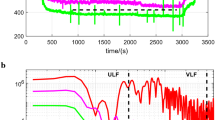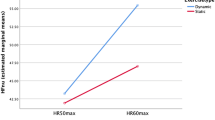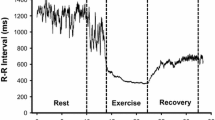Abstract
Since heart rate variability (HRV) during the first minutes of the recovery after exercise has barely been studied, we wanted to find out HRV dynamics immediately after five different constant-speed exercises. Thirteen sedentary women performed two low-intensity (3,500 m [3,500LI] and 7,000 m [7,000LI] at 50% of the velocity of VO2max [vVO2max]), two moderate-intensity (3,500 m [3,500MI] and 7,000 m [7,000MI] at ∼63% vVO2max) and one high-intensity (3,500 m at ∼74% vVO2max [3,500HI]) exercises on a treadmill. HRV was analyzed with short-time Fourier transform method during the 30-min recovery. High frequency power (HFP) was for the first time higher than at the end of the exercise after the first minute of the recovery (3,500LI and 7,000LI, P < 0.001), after the fourth (3,500MI, P < 0.05) and the fifth (7,000MI, P < 0.05) minute of the recovery and at the end of the 30-min recovery (3,500HI, P < 0.01). There were no differences in HRV between 3,500LI and 7,000LI or between 3,500MI and 7,000MI during the recovery. The levels of HFP and TP were higher during the whole recovery after 3,500LI compared to 3,500MI and 3,500HI. We found increased HFP, presumably caused by vagal reactivation, during the first 5 min of the recovery after each exercise, except for 3,500HI. The increased intensity of the exercise resulted in slower recovery of HFP as well as lower levels of HFP and TP when compared to low-intensity exercise. Instead, the doubled running distance had no influence on HRV recovery.




Similar content being viewed by others
References
Arai Y, Saul J, Albrecht P, Hartley L, Lilly L, Cohen R, Colucci W (1989) Modulation of cardiac autonomic activity during and immediately after exercise. Am J Physiol 256:H132–H141
Aunola S, Rusko H (1984) Reproducibility of aerobic and anaerobic thresholds on 20–50 year old men. Eur J Appl Physiol 53:260–266
Akselrod S, Gordon D, Ubel F, Shannon D, Barger A, Cohen R (1981) Power spectrum analysis of heart rate fluctuation: a quantitative probe of beat-to-beat cardiovascular control. Science 213:220–222
Bartels M, Jelic S, Ngai P, Gates G, Newandee D, Reisman S, Basner R, De Meersman R (2004) The effect of ventilation on spectral analysis of heart rate variability during exercise. Respir Phys Neurobiol 144:91–98
Berntson G, Cacioppo J, Quigley K (1993) Respiratory sinus arrhythmia: autonomic origins, physiological mechanisms, and psychophysiological implications. Psychophysiology 30:183–196
Cacioppo J, Berntson G, Binkley P, Quigley K, Uchino B, Fieldstone A (1994) Autonomic cardiac control II. Noninvasive indices and basal response as revealed by autonomic blockades. Psychophysiology 31:586–598
Casadei B, Cochrane S, Johnston J, Conway J, Sleight P (1995) Pitfalls in the interpretation of spectral analysis of the heart rate variability during exercise in humans. Acta Physiol Scand 153:125–131
Casties J-F, Mottet D, Le Gallais D (2006) Non-linear analysis of heart rate variability during heavy exercise and recovery in cyclists. Int J Sports Med 27:780–785
Cottin F, Medigue C, Leprêtre P-M, Papelier Y, Koralsztein J-P, Billat V (2004) Heart rate variability during exercise performed below and above ventilatory threshold. Med Sci Sports Exerc 36:594–600
Elsenbruch S, Wang Z, Orr W, Chen J (1999) Time-frequency analysis of heart rate variability using short-time Fourier analysis. Physiol Meas 21:229–240
Furlan R, Piazza S, Dell’Orto S, Gentile E, Cerutti S, Pagani M, Malliani A (1993) Early and late effects of exercise and athletic training on neural mechanisms controlling heart rate. Cardiovasc Res 27:482–488
Grossman P, Karemaker J, Wieling W (1991) Prediction of tonic parasympathetic cardiac control using respiratory sinus arrhythmia: the need for respiratory control. Psychophysiology 28:201–216
Goldberger J, Le F, Lahiri M, Kannankeril P, Ng J, Kadish A (2006) Assesment of para-sympathetic reactivation after exercise. Am J Physiol 290:2446–2452
Kaikkonen P, Rusko H, Martinmäki K (2007) Post-exercise heart rate variability of endurance athletes after different high-intensity exercises. Scand J Med Sci Sports (in press)
Keselbrener L, Akselrod S (1996) Selective discrete Fourier transform algorithm for time-frequency analysis: method and application on simulated and cardiovascular signals. IEEE Trans Biomed Eng 43:789–802
Martinmäki K, Rusko H (2007) Time–frequency analysis of heart rate variability during immediate recovery from low and high intensity exercise. Eur J Appl Physiol (submitted)
Martinmäki K, Rusko H, Kooistra L, Kettunen J, Saalasti S (2006a) Intraindividual validation of heart rate variability indexes to measure vagal effects on hearts. Am J Physiol 290:H640–647
Martinmäki K, Rusko H, Saalasti S, Kettunen J (2006b) Ability of short-time Fourier transform to detect transient changes in vagal effects on hearts: a pharmacological blocking study. Am J Physiol 290:2582–2589
Miles D, Sawka M, Hanpeter D, Foster J, Doerr B, Basset Frey M (1984) Central hemodynamics during progressive upper and lower body exercise and recovery. J Appl Physiol 57:366–370
Mourot L, Bouhaddi M, Tordi N, Rouillon J-D, Regnard J (2004) Short- and long-term effects of a single bout of exercise on heart rate variability: comparison between constant and interval training exercises. Eur J Appl Physiol 92:508–517
Oida E, Moritani T, Yamori Y (1997) Tone-entropy analysis on cardiac recovery after dynamic exercise. J Appl Physiol 82:1794–1801
O’Leary D (1993) Autonomic mechanisms of muscle metaboreflex control of heart rate. J Appl Physiol 74:1748–1754
Parekh A, Lee M (2005) Heart rate variability after isocaloric exercise bouts of different intensities. Med Sci Sports Exerc 37:599–605
Perini R, Orizio C, Baselli G, Cerutti S, Veicsteinas A (1990) The influence of exercise intensity on the power spectrum of heart rate variability. Eur J Appl Physiol 61:143–148
Pichon A, De Bisschop C, Roulaud M, Denjean A, Papelier Y (2004) Spectral analysis of heart rate variability during exercise in trained subjects. Med Sci Sports Exerc 36:1702–1708
Pierpont G, Stolpman D, Gornick C (2000) Heart rate recovery post-exercise as an index of parasympathetic activity. J Auton Nerv Syst 80:169–174
Plotnick C, Becker L, Fisher M (1986) Changes in left ventricular function during recovery from upright bicycle exercise in normal persons and patients with coronary artery disease. Am J Cardiol 58:247–251
Savin W, Davidson D, Haskell W (1982) Autonomic contribution to heart rate recovery from exercise in humans. J Appl Physiol 53:1572–1575
Task Force of the European Society of Cardiology and the North American Society of Pacing and electrophysiology (1996) Heart rate variability: standards of measurement, physiological interpretation and clinical use. Circulation 93:1043–1065
Terziotti P, Schena F, Gulli G, Cevese A (2001) Post-exercise recovery of autonomic cardiovascular control: a study by spectrum and cross-spectrum analysis in humans. Eur J Appl Physiol 84:187–194
Tulppo M, Mäkikallio T, Seppänen T, Laukkanen R, Huikuri H (1998) Vagal modulation of heart rate during exercise: effects of age and physical fitness. Am J Physiol 274:424–429
Author information
Authors and Affiliations
Corresponding author
Rights and permissions
About this article
Cite this article
Kaikkonen, P., Nummela, A. & Rusko, H. Heart rate variability dynamics during early recovery after different endurance exercises. Eur J Appl Physiol 102, 79–86 (2007). https://doi.org/10.1007/s00421-007-0559-8
Accepted:
Published:
Issue Date:
DOI: https://doi.org/10.1007/s00421-007-0559-8




